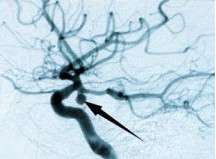The Medical Minute: Pipes in the brain as treatment for aneurysms

Brain aneurysms are balloon-like out-pouchings that can develop off of brain arteries. Like balloons, these out-pouchings can burst causing a devastating type of stroke as blood leaks in and around the brain. Many years ago brain aneurysms could only be treated with a major, invasive surgical procedure that involved opening the skull and working around the folds of the brain to place a metal clip across the base of the aneurysm. This procedure usually took several hours, required a hospital stay of about a week and often left patients out of work for several weeks. In recent years, minimally invasive brain aneurysm treatment called aneurysm coil embolization or aneurysm coiling has become increasingly popular.
During an aneurysm coiling procedure, doctors introduce a catheter into an artery in the upper leg through a small, quarter-inch incision. This catheter is guided up into an artery in the neck that is feeding the brain. From there, a smaller, thinner micro-catheter (about the size of a thin piece of spaghetti) is directed into the brain aneurysm itself. Fine, soft loops of platinum wire called coils are then placed inside the aneurysm to close it off. While this procedure works well for many types of brain aneurysms, some large aneurysms or ones with a broad or wide base can be very difficult to completely and permanently treat in this manner.
Penn State Hershey Medical Center recently became only the second hospital in Pennsylvania and one of only about 30 institutions in the country to start using a revolutionary new, minimally-invasive device to treat brain aneurysms. This new device called Pipeline is a specialized kind of stent or mesh-like tube that is placed in the artery that harbors the aneurysm. The device channels blood away from the aneurysm causing the aneurysm to seal off.
The Pipeline device is part of a novel class of devices, called flow-diverters, to be FDA-approved for patient use in the United States. Pipeline provides a new method to successfully treat these challenging broad-based aneurysms. Placement of a Pipeline device is accomplished in a way very similar to the coil embolization procedure in that catheters are guided through the patient’s arteries to the aneurysm. However, instead of placing any material in the aneurysm itself, the Pipeline device is placed in the artery adjacent to the aneurysm. The length of the procedure varies depending on the complexity of the aneurysm, but many treatments can be accomplished in two to three hours. Patients usually stay in the hospital for one or two days and recovery time is short, with many people returning to work within a week or two. Only certain large or giant aneurysms can be treated with this technique, and since the device is left in a brain artery, patients must take a combination of blood thinning drugs for several months after the procedure until the Pipeline device has fully healed into the artery.
More information: More information about aneurysms is available here.












